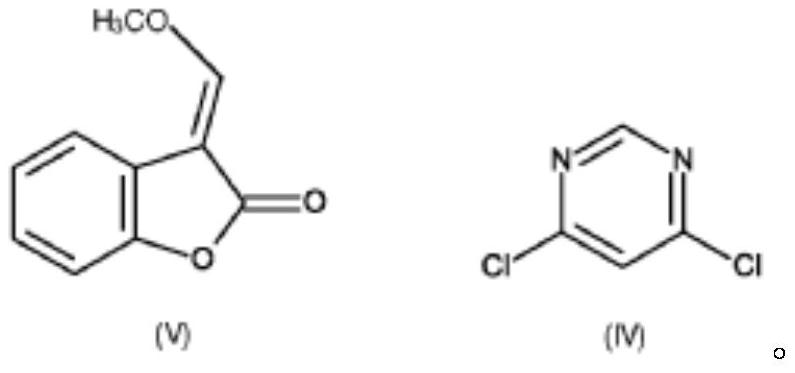Process for preparation of azoxystrobin and intermediates thereof
A technology of azoxystrobin and methyl propionate, applied in the field of preparing strobilurin compounds, capable of solving the problems of low purity and low yield
- Summary
- Abstract
- Description
- Claims
- Application Information
AI Technical Summary
Problems solved by technology
Method used
Image
Examples
Embodiment 1
[0239] (E) Preparation of methyl 2-{2-[6-chloropyrimidin-4-yloxy]phenyl}-3-methoxyacrylate (compound IIa)
[0240] To a stirred mixture of 3-(methoxymethylene)-2(3H)-benzofuranone (97%, 91 g, 0.5 mol) in methyl formate (275 g) was added 4, 6-Dichloropyrimidine (98%, 92 g, 0.605 mol). At 10°C to 15°C, 1,8-diazabicyclo[5,4.0]undec-7-ene (0.038g, 0.249mmol, 0.05mol%) was added to the above reaction mixture, then dropwise Add sodium methoxide (30%, 110 g, 0.61 mol) in methanol. After the addition was complete, the reaction mass was maintained at 10°C to 15°C for 1 hour. Methyl formate was then distilled off from the mixture while maintaining the temperature below 55°C. Toluene (300ml) and water (200ml) were added to the remaining residue, and the mixture was stirred at 60°C to 65°C. The mixture was cooled to room temperature, and the organic layer was separated. Toluene was distilled off under reduced pressure, and the oily residue was heated to 130°C to 135°C. Potassium b...
Embodiment 2
[0242] (E) Preparation of methyl 2-{2-[6-chloropyrimidin-4-yloxy]phenyl}-3-methoxyacrylate (compound IIa)
[0243] To a stirred mixture of 3-(methoxymethylene)-2(3H)-benzofuranone (97%, 91 g, 0.5 mol) in methyl formate (275 g) was added 4, 6-Dichloropyrimidine (98%, 92 g, 0.605 mol). At 10°C to 15°C, 1,5-diazabicyclo[4.3.0]non-5-ene (0.031 g, 0.249 mmol, 0.05 mol%) was added to the reaction mixture followed by dropwise addition of sodium methoxide (30% in methanol, 110 g, 0.61 mol). The reaction mass was maintained at 10°C to 15°C for 1 hour. The methyl formate was then distilled off while keeping the temperature below 55°C. Toluene (300ml) and water (200ml) were added to the residue, and the mixture was stirred at 60°C to 65°C. The mixture was cooled to room temperature, and the organic layer was separated. Toluene was distilled off under reduced pressure, and the oily residue was heated to 130°C to 135°C. Potassium bisulfate (1.36 g, 0.01 mol) was added and the reactio...
Embodiment 3
[0244] Embodiment 3 (comparative example)
[0245] Preparation of (E)-methyl 2-{2-[6-chloropyrimidin-4-yloxy]phenyl}-3-methoxyacrylate (IIa) in the absence of catalyst:
[0246] To a stirred mixture of 3-(methoxymethylene)-2(3H)-benzofuranone (97%, 91 g, 0.5 mol) in methyl formate (275 g) was added 4, 6-Dichloropyrimidine (98%, 92 g, 0.605 mol). Sodium methoxide (30% in methanol, 110 g, 0.61 mol) was added dropwise to the reaction mixture at 10°C to 15°C. The reaction mass was maintained at 10°C to 15°C for 1 hour. Methyl formate was distilled off at atmospheric pressure while maintaining the temperature below 55°C. Toluene (300ml) and water (200ml) were added to the residue, and the mixture was heated to 60°C to 65°C. The mixture was cooled to room temperature, and the organic layer was separated. Toluene was distilled off under reduced pressure, and the oily residue was heated to 130°C to 135°C. Potassium hydrogen sulfate (1.36 g, 0.01 mol) was added to the mixture, ...
PUM
 Login to View More
Login to View More Abstract
Description
Claims
Application Information
 Login to View More
Login to View More - R&D
- Intellectual Property
- Life Sciences
- Materials
- Tech Scout
- Unparalleled Data Quality
- Higher Quality Content
- 60% Fewer Hallucinations
Browse by: Latest US Patents, China's latest patents, Technical Efficacy Thesaurus, Application Domain, Technology Topic, Popular Technical Reports.
© 2025 PatSnap. All rights reserved.Legal|Privacy policy|Modern Slavery Act Transparency Statement|Sitemap|About US| Contact US: help@patsnap.com



